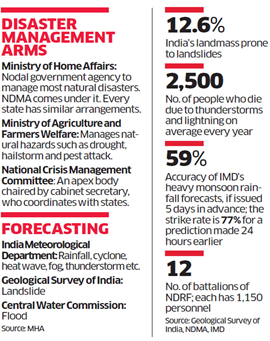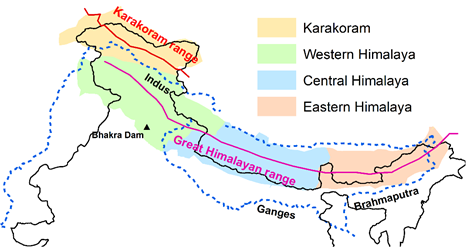

|
Overview
|
Context
There is a need to pre-empt the disastrous effects of unregulated tourism and learn lessons from the over-exploited tourist destinations in the Himalayan region, highlighted in a report published named- ‘Environmental assessment of tourism in the Indian Himalayan region’.
Background
- The Himalayas are ecologically fragile and economically underdeveloped, with geo-environmental constraints imposing severe limitations on the level of resource productivity.
- Consequently, subsistence agriculture constitutes the main source of livelihood in the region.
- The rapid growth of tourists in the region has brought about extensive land-use changes in the region, mainly through the extension of cultivation and large-scale deforestation.
- This irrational land transformation process has not only disrupted the ecological balance of the Himalayan watersheds through reduced groundwater recharge, increased run-off and soil erosion, but has also adversely affected the ecology and economy of the adjoining Indo-Gangetic plains by recurrent floods and decreased irrigation potential.
|
The Himalayas
|
Analysis
Key Highlights of the Report
- There is a need to scrutinize the disastrous effects of unregulated tourism and learn lessons from the over-exploited tourist destinations in the Himalayan region.
- The demand for tourism has increased pressure on hill stations. It is becoming a major concern for change in land use and land cover.
|
Tourism Potential of India
|
Why Himalayan region is susceptible to disasters?
The Hindu Kush Himalayan region is prone to numerous types of disasters because of its
- Steep terrain
- fragile geology
- intense and variable precipitation
- Common incidents of floods and landslides
- neo-tectonic mountain-building process, like earthquakes, landslides, floods, etc
- Other factors
- Overexploitation of the ecosystem (tourism, increased consumerism)
- Exploitative development projects: The indiscriminate exploitation of the fragile Himalayan region in the name of development projects has extracted a heavy price in terms of environmental damage.
- Fragmentation of natural resources: String of hydroelectric and road projects in the Himalayan States have already resulted in the fragmentation of natural systems.
|
Recent events
|
Impacts of Unregulated Tourism in Himalayas
The negative environmental impacts of tourism are substantial. They include:
- Floods, landslides and forest fires
- Leads to overuse of water: Example is Ladakh, an area with water deficiency. It is mostly dependent on snow / glacial melt and flow of River Indus. Individual water consumption by a resident is 75 litres per day on an average, whereas a tourist consumes about 100 l / day.
- Greenhouse gas emission: Tourism contributes to more than 5 per cent of global greenhouse gas emissions, with transportation accounting for 90 per cent of this.
- Changing land use pattern: Tourism puts enormous stress on local land use, and can lead to soil erosion, increased pollution, natural habitat loss, and more pressure on endangered species.
- Earthquakes: Himalayan region comes under Zone V of the earthquake which indicates highest earthquake prone regions of India. Regardless of this, people continue to use these places adding to its vulnerability for disasters.
- Floods: Due to the presence of perennial river systems originating from glaciers in Himalayas, the region has high probability of floods. Rivers are in their youthful stage and makes turns through the valleys of the mountains.
- Hence excessive tourism in the region will lead to more heat in hill region and more water start to melt and increases flow in the rivers leading to floods.
- Biodiversity losses: Indigenous as well as migrant species and birds are present in the Himalayan ecosystem which is one of India’s most diverse and rich Biodiversity Hotspot on Earth.
- With increasing Human interventions and practices with climate change we are making this heritage vague.
Sustainable tourism in Himalayas: Recommendations
- Regulated tourism practice: There is need to establish regulated tourism practices with promotion of sustainable agendas for the Indian Himalayan region (IHR).
- Also, there is need of maintenance of proper tourist capacity in every tourist place.
- Vigilance and patrolling: Protected areas require vigilance and regular patrolling to reduce unwanted wildlife-tourist interaction as well as habitat destruction due to off-road driving and encroachment.
- Early Warning System:It is important to have early warning and better weather forecast systems in order to forecast the disaster and alert the local population and tourists.
- Regional Cooperation:There is a need for a trans-boundary coalition of Himalayan countries to share and disseminate knowledge about the mountains and preservation of the ecology there.
- Area Specific Sustainable Plan:What is most critical is to review the area’s present status and draw up a sustainable plan that respects the specific requirements of this fragile region and the impact of the climate crisis.
- Promote Ecotourism:Initiating a dialogue on adverse impacts of commercial tourism and promoting ecotourism.

Conclusion
Tourism is all about enjoying the gifts of nature and people and appreciating beautiful sights responsibly. However, it goes against the nature where it poses more negative than positive effects on the tourist sites, local communities, and the economy. Therefore, there is need of ‘responsible tourism’, that respects the tourism destination's environment, community, and culture and also correct the adverse effects caused by irresponsible mass tourism.
This type of tourism aims to create sustainable tourism development that protects the interest of local communities and the heritage sites within these communities.
|
PRACTICE QUESTION Q1. Discuss the issues posed by tourism in the Himalayan states. What measures are required to overcome them? Q2. Eco-Tourism can become one of the mainstays of Indian economy if certain basic issues are taken care of. Examine. |




